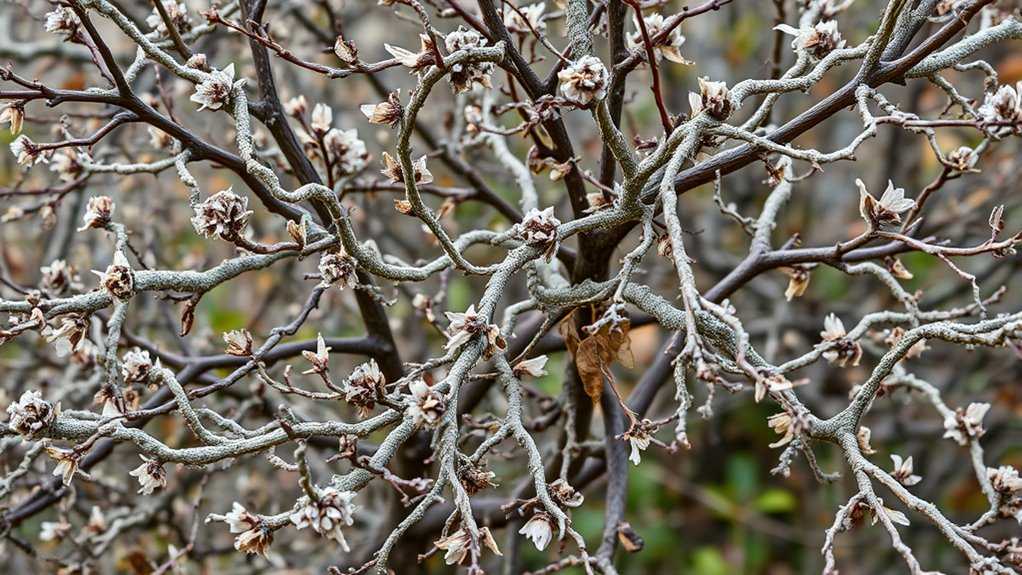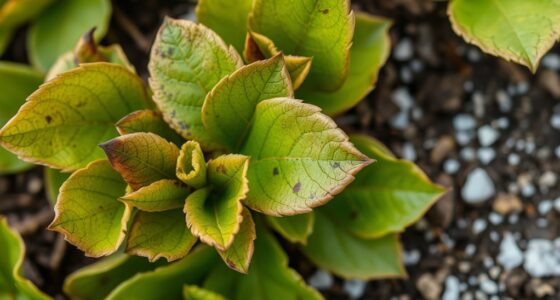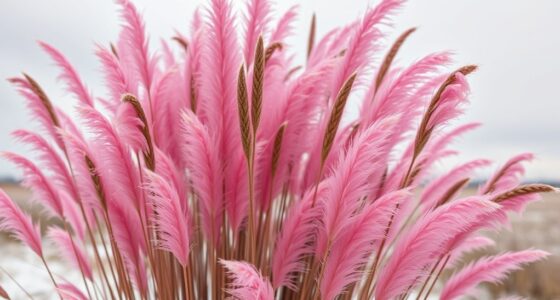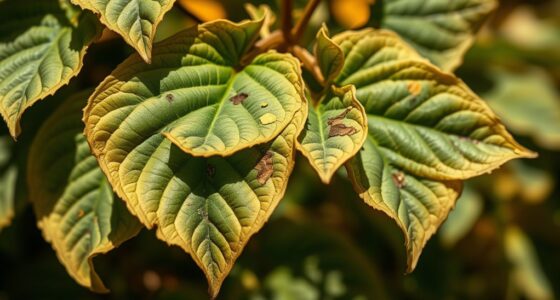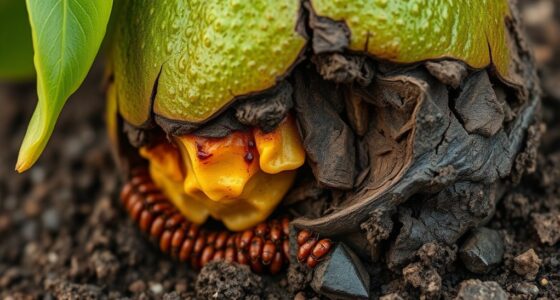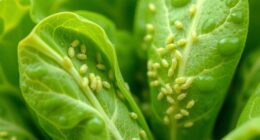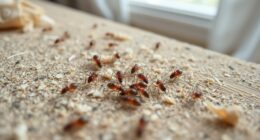To tell if your Indian Hawthorn can be saved, check its branches for green, moist tissue by scratching the bark; if it’s brown and dry, that part’s likely dead. Look at the foliage—dull or browning leaves suggest stress, but green tissue indicates potential recovery. Examine the roots for softness or decay, and consider seasonal timing for pruning. If you’re unsure, you’ll find helpful tips on how to assess and revive your plant further along.
Key Takeaways
- Perform a scratch test on branches; green tissue suggests the plant can still recover.
- Check if the bark is moist and green underneath, indicating viable, living tissue.
- Look for signs of new growth or buds during the growing season as recovery indicators.
- Examine roots for firmness and color; healthy roots are white or light tan, soft roots signal decay.
- Assess overall plant health, including foliage and branches; some signs of decline may still be reversible with proper care.
Signs of Life: Examining the Foliage and Branches

When evaluating the health of your Indian hawthorn, start by closely examining its foliage and branches. Look for vibrant, green leaves as a sign of life; dull or browning foliage may indicate stress. Check the soil moisture around the plant—if the soil is too dry, the shrub could be suffering from dehydration, affecting its importance. If you notice dead or damaged branches, consider using proper pruning techniques to stimulate new growth and improve air circulation. When pruning, make clean cuts just above healthy buds or nodes. This encourages the plant to focus energy on healthy tissue and can help revive it. Regularly monitoring soil moisture and applying precise pruning can considerably improve your Indian hawthorn’s chances of recovery. Additionally, understanding herbal teas and their calming effects can help in creating a stress-free environment for your plant’s care. For example, some gardeners recommend using natural remedies like compost teas to boost plant vitality. Remember, taking a holistic approach to plant health can enhance your efforts and increase the likelihood of revival.
Checking the Roots for Damage or Decay

Start by examining the roots’ color—healthy ones are usually white or light tan, while dark or black roots indicate trouble. Gently feel the roots for softness; squishy or slimy textures suggest decay. Also, check for any fungal growth or foul smell, which can signal root rot and further damage. Recognizing the signs of plant stress can help determine whether your Indian Hawthorn can be saved. Understanding plant health indicators can guide you in making effective decisions for recovery. Incorporating mindfulness techniques such as careful observation can aid in assessing subtle changes in your plant’s condition.
Inspect Root Coloration
To determine if your Indian Hawthorn’s roots are healthy, carefully examine their coloration. Healthy roots are typically white or light tan and firm to the touch. Dark, brown, or black roots may indicate decay or disease. Soft, slimy roots suggest rot, often caused by overwatering or poor soil drainage. When inspecting, consider how your watering frequency affects root health; overwatering can lead to root decay, while proper soil amendments can improve drainage.
Here are key points to assess:
- Look for white or light tan roots that are firm and moist.
- Check for dark, brown, or black roots indicating decay.
- Notice if roots feel soft or slimy, signaling rot.
- Adjust watering habits and incorporate soil amendments to promote healthy growth.
Detect Root Softness
Feeling the roots directly can reveal much about their condition. Gently dig around the base of your Indian hawthorn to expose the roots without causing further damage. Check for softness or mushiness, which indicate root rot or decay. Healthy roots should feel firm and resilient. Poor soil drainage and irregular watering practices often lead to soft, damaged roots, so consider these factors. If you notice softness, it’s a sign of overwatering or poorly draining soil that traps moisture around the roots. To prevent further damage, adjust your watering schedule and improve soil drainage if needed. Remember, firm roots are a good sign, while soft or slimy ones suggest your plant may need more care or even removal. Proper watering techniques are essential to prevent root issues and maintain healthy growth. Additionally, understanding the importance of soil drainage can help you create an environment that promotes root health and prevents decay. Regularly inspecting roots and understanding plant health signals can help you catch issues early and save your plant from decline.
Look for Fungal Growth
Fungal growth on the roots is a clear sign of damage or decay that you should not ignore. When inspecting your Indian hawthorn, look for dark, fuzzy, or slimy patches around the root zone. This fungal growth indicates potential disease diagnosis issues that threaten your plant’s health. To assess the severity, consider these steps:
- Gently lift the plant to expose the roots without causing further damage.
- Examine the roots for any soft, discolored, or mushy areas.
- Identify visible fungal growth, such as white mold or black spots.
- Note any foul odor, which often accompanies root decay caused by fungal infection.
- Remember that proper maintenance can prevent many fungal problems and promote healthy root systems. Regular monitoring and sanitation are vital to avoid root rot and other fungal issues. Being aware of plant health indicators can help you detect problems early and take appropriate action to save your plant.
Early detection of fungal growth helps determine if the plant can be saved or needs removal.
The Importance of Seasonal Changes and Timing

Seasonal changes play a essential role in the health and appearance of plants like the Indian Hawthorn. Understanding its natural flowering cycles helps you plan proper care throughout the year. During the growing season, you can perform seasonal pruning to remove dead or damaged branches, encouraging healthy growth and blooms. Timing is critical: pruning too early or too late can disrupt flowering cycles and weaken the plant. Recognizing when your Indian Hawthorn is in its active growth phase ensures you give it the right attention at the right time. Proper timing helps maintain its overall health and aesthetic appeal. Additionally, understanding plant dormancy patterns can aid in determining the best times to intervene and promote healthy regrowth. Being aware of seasonal timing can help you optimize your care routines for better results. Knowing the growth cycle of the Indian Hawthorn allows you to tailor your maintenance practices more effectively, ensuring the plant’s resilience.
How to Perform a Scratch Test to Assess Viability

Choose a healthy-looking branch and gently scrape away a small section of bark. Check the exposed surface for a green or moist color, which indicates the plant is still viable. If the color is brown or dry, the branch may no longer be alive. Additionally, inspecting for plant health indicators can provide further insight into the overall vitality of your Indian Hawthorn. Monitoring for signs of disease or pests can also help determine if the plant needs special care or removal. Regular observation of air quality or environmental conditions can further influence your plant’s recovery prospects.
Select a Healthy Branch
To determine if a branch is still alive, perform a simple scratch test by removing a small patch of bark with your fingernail or a sharp knife. If the underlying tissue is green and moist, the branch is viable. When selecting a healthy branch, consider these factors:
- Check for flexible, green tissue beneath the bark, indicating vitality.
- Avoid brittle or brownish branches, which suggest deadwood.
- Prune carefully, using proper pruning techniques to promote recovery.
- Improve soil conditions with amendments to support regrowth and overall plant health.
Focusing on healthy branches helps ensure your efforts in pruning techniques and soil amendments lead to a thriving Indian hawthorn. Always choose branches with signs of life to maximize your chances of saving the plant.
Scrape the Bark Surface
Performing a scratch test is a straightforward way to determine if a branch of your Indian hawthorn is still alive. Gently scrape away a small section of bark with your fingernail or a knife, exposing the underlying tissue. Pay attention to the bark texture; healthy bark should feel firm and slightly moist. Look for color changes beneath the surface—if the tissue is green or moist, the branch likely remains viable. If the exposed area is brown, dry, or brittle, that indicates the branch may be dead. Be careful not to damage the surrounding bark. This simple test helps you assess whether the branch can recover or if it’s time to prune away the deadwood. Regular monitoring of plant health can help prevent issues and guide proper care. Recognizing signs of vitality early can improve your plant’s recovery and promote healthy growth in the future.
Observe Color Change
Have you checked the color of the tissue beneath the bark after scraping? This reveals crucial clues about your plant’s health. Look for a healthy, moist, and greenish hue, indicating viability. A gray, brown, or black color suggests dead tissue. Pay attention to leaf discoloration around the area; healthy leaves typically remain vibrant, while discolored or wilting leaves may signal trouble.
To assess properly, consider these steps:
- Gently scrape a small section of bark with a fingernail or knife.
- Observe the color change beneath the surface.
- Compare the tissue color to healthy tissue standards.
- Assess leaf discoloration and overall plant vigor.
This quick test helps determine if your Indian hawthorn can recover or if it’s beyond saving.
Recognizing Stress Symptoms Versus Deadness

When evaluating your Indian hawthorn, it’s important to distinguish between stress symptoms and actual deadness. A plant showing stress may have yellowing leaves, wilting, or sparse growth but still retain some green tissue, indicating it can recover. Check your fertilizer application and watering schedule—overwatering can cause root rot, while underwatering leads to drought stress. Adjust your watering habits accordingly, ensuring the soil remains moist but not soggy. Proper fertilization can also promote healthy growth, helping the plant bounce back. Dead branches or twigs usually feel dry and brittle and won’t show signs of new growth. If you notice some healthy, green tissue amid the stressed parts, the plant might still be saved with proper care. Recognizing these signs early is key to reviving your hawthorn.
Common Diseases and Pests That Mimic Death

Certain diseases and pests can cause symptoms that closely resemble dead or dying plants, making it tricky to diagnose the true condition of your Indian hawthorn. To accurately identify the problem, start with pest identification by inspecting leaves, stems, and roots for signs of infestations or damage. Sometimes, pests like scale insects or aphids hide beneath foliage, mimicking plant decline. Soil testing is also essential to detect nutrient deficiencies or root rot that may appear as a dead plant. Be aware of these common culprits:
Identify pests, diseases, and soil issues to diagnose your Indian hawthorn’s decline accurately.
- Fungal diseases like leaf spot or root rot
- Pest infestations such as scale or aphids
- Nutrient deficiencies mimicking decline
- Soil-borne issues affecting root health
Proper diagnosis guarantees you treat the real cause, not just the symptoms.
The Role of Environmental Factors in Plant Decline

Environmental conditions play a significant role in the health of your Indian hawthorn, often exacerbating issues caused by pests or diseases. Poor soil composition can limit root access to nutrients and water, weakening the plant. Overwatering or underwatering disrupts its ability to absorb essential moisture, leading to stress and decline. To understand these impacts better, consider this table:
| Soil Composition | Watering Practices |
|---|---|
| A well-draining mix prevents root rot | Water deeply but infrequently |
| Heavy clay traps moisture | Avoid frequent shallow watering |
| Nutrient-rich soil promotes growth | Adjust watering based on season |
| Poor soil leads to nutrient deficiency | Monitor soil moisture levels |
When to Prune and Remove Dead Material

Pruning and removing dead material at the right time is essential for maintaining your Indian hawthorn’s health and encouraging new growth. Proper pruning techniques and timing to contemplate you don’t damage the plant or spread disease. Ideally, prune during late winter or early spring before new growth starts. Here are key points to consider:
- Assess the plant regularly for dead or diseased branches.
- Use sharp, clean tools to make clean cuts.
- Remove dead or broken branches first, cutting back to healthy tissue.
- Avoid heavy pruning during hot or stressful periods, as it can hinder recovery.
Techniques for Reviving a Severely Damaged Indian Hawthorn

When your Indian hawthorn has sustained severe damage, quick and targeted action can help revive its significance. Start by improving the soil with amendments like compost or organic matter to enhance drainage and nutrient availability. Proper watering techniques are essential; water deeply but infrequently to encourage deep root growth, ensuring the soil stays moist but not waterlogged. Avoid overwatering, which can cause root rot, and ensure the plant receives consistent moisture during its recovery. Prune any severely damaged or dead branches to reduce stress and promote new growth. Consider applying a balanced fertilizer to support recovery. Regularly monitor soil moisture and adjust watering as needed. These techniques help restore vitality to a struggling Indian hawthorn, giving it a better chance to bounce back.
When to Seek Professional Help or Consider Replanting

If your Indian hawthorn shows no signs of improvement after consistent care and a few weeks have passed, it’s time to contemplate seeking professional help or replanting. You should evaluate whether soil improvement or adjusted watering practices could still revive it. If these measures haven’t helped, consider these steps:
- Consult an arborist or horticulturist for expert diagnosis.
- Assess root health; if roots are rotted or severely damaged, replanting might be necessary.
- Determine if the soil is too compacted or lacking nutrients, which could require soil amendment.
- Decide if the plant’s overall health is beyond recovery, prompting replanting in a better location or with improved soil conditions.
Recognizing when to act can save your garden’s aesthetic and your effort.
Frequently Asked Questions
Can Indian Hawthorn Recover From Severe Drought Conditions?
You might wonder if your Indian Hawthorn can recover from severe drought. While drought resilience varies, you can try plant recovery techniques like deep watering and mulching to help it bounce back. Assess the plant’s health by checking for new growth or green foliage, and be patient. If the roots are still alive, there’s a good chance it can recover with proper care and attention.
What Are Natural Remedies to Revive a Dying Indian Hawthorn?
To revive a dying Indian hawthorn, you should focus on natural remedies like enriching the soil with organic amendments such as compost or aged manure to improve drainage and nutrient levels. Use proper pruning techniques to remove dead or damaged branches, encouraging healthy growth. Keep the plant well-watered but avoid overwatering, and consider mulching to retain moisture. These steps support recovery and boost your plant’s health naturally.
How Long Should I Wait Before Replacing a Dead Indian Hawthorn?
Imagine waiting six weeks after noticing your Indian hawthorn’s branches are brown and brittle. Timing considerations for replacement guidelines suggest you should wait at least this long to see if it shows signs of recovery. If no new growth appears, it’s best to replace the shrub. Patience helps avoid unnecessary removal, but don’t delay too long, as dead plants can attract pests and disease.
Are There Specific Fertilizers That Promote Recovery of Stressed Plants?
You can help stressed plants recover by using fertilizers that boost soil nutrients, encouraging healthy growth. Look for formulas with balanced or slow-release nutrients to prevent overfeeding. Organic supplements like compost or fish emulsion also promote recovery by enriching the soil naturally. Apply fertilizers according to package instructions, ensuring even distribution. This approach supports your plant’s resilience and improves its chances of bouncing back from stress.
Does Overwatering Cause More Harm Than Drought to Indian Hawthorn?
Overwatering is like drowning a plant before it’s had a chance to breathe. It causes root rot because excess water fills the soil and blocks oxygen, especially if soil drainage is poor. Drought stresses plants too, but overwatering does more immediate harm by suffocating roots. To protect your Indian hawthorn, guarantee proper soil drainage and avoid watering too frequently, helping it stay healthy and resilient.
Conclusion
If your Indian hawthorn shows signs of life like healthy foliage and firm branches, don’t give up just yet. Think of it as a stubborn survivor, fighting to thrive despite setbacks. With patience and proper care—checking roots, performing a scratch test, and pruning wisely—you might just bring it back from the brink. If unsure, don’t hesitate to call in a pro. Your plant’s future depends on your keen eye and gentle hands.
